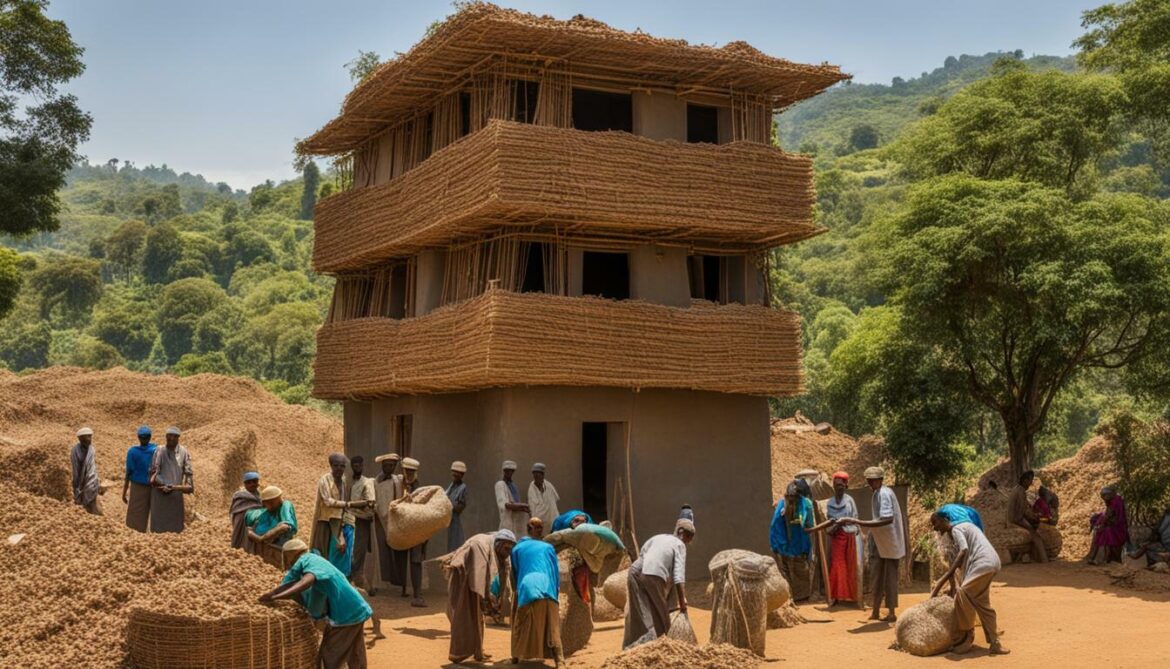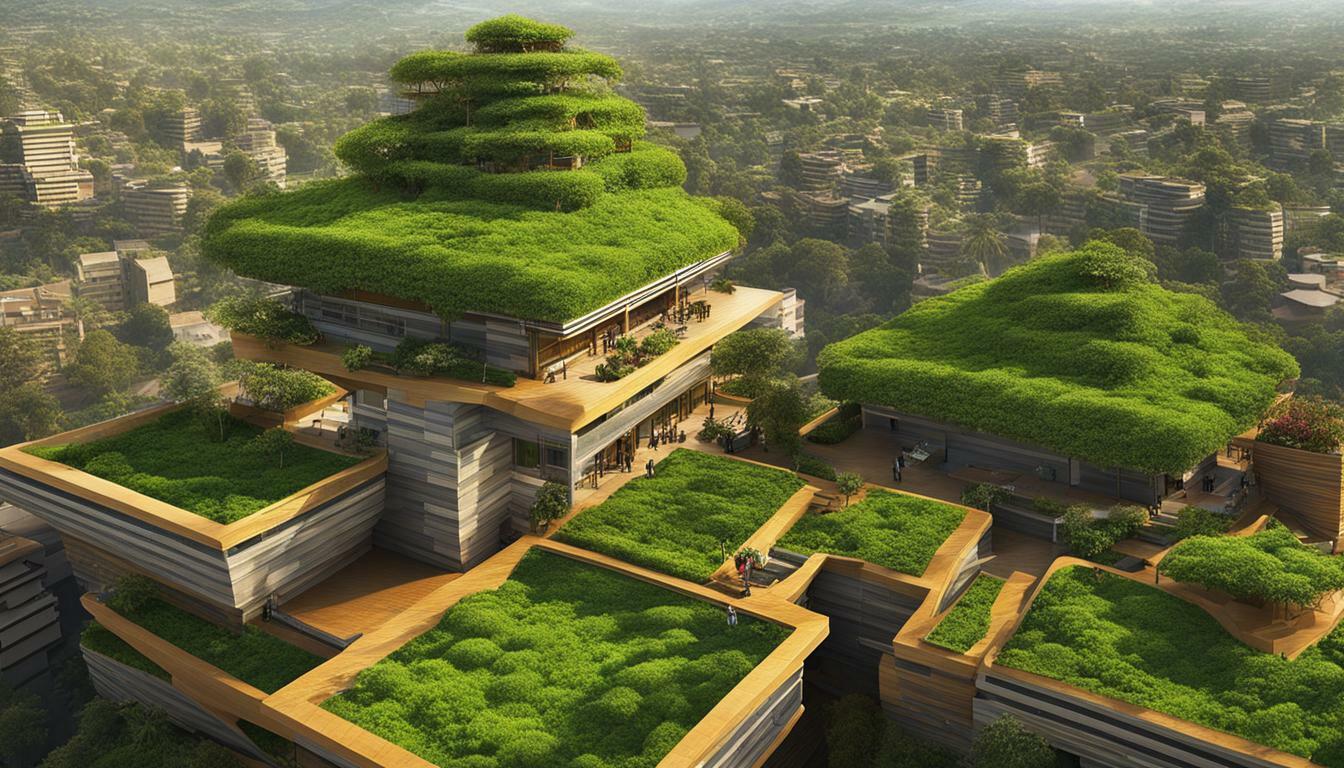Ethiopia is experiencing rapid urbanisation and increased demand for housing, leading to a growing need for sustainable architecture and energy-efficient construction practices. The construction industry has a significant impact on the environment, with buildings contributing to greenhouse gas emissions and energy consumption. However, green building practices and technologies offer a solution to minimize these negative effects. While Ethiopia is slowly adopting green building concepts and technologies, there are only a few certified buildings in the country.
One notable project is the Addis Ababa River Side Green Development Project, which incorporates sustainable design and construction methods. Another innovative approach is the use of earthbag construction for relief housing, which utilises locally available materials and follows the principles of cradle-to-cradle design.
Despite these efforts, there is still a need for more research and initiatives to promote the adoption of green building practices in Ethiopia. By prioritising sustainable architecture and energy-efficient construction, Ethiopia can reduce its carbon footprint and create a more environmentally friendly built environment.
Key Takeaways:
- Ethiopia is facing rapid urbanisation and increased demand for housing.
- Green building practices and technologies offer a solution to minimise negative environmental impact.
- The Addis Ababa River Side Green Development Project is a notable example of sustainable design and construction.
- Earthbag construction for relief housing utilises locally available materials and follows cradle-to-cradle design principles.
- More research and efforts are needed to promote the adoption of green building practices in Ethiopia.
The Addis Ababa River Side Green Development Project
One of the remarkable green building initiatives in Ethiopia is the Addis Ababa River Side Green Development Project, which showcases the incorporation of sustainable building materials and cutting-edge green building technologies. This project aims to address the increasing demand for housing in Addis Ababa, while also prioritizing environmental sustainability.
The project utilizes a variety of sustainable building materials, including locally sourced bamboo and reclaimed timber, which helps reduce the carbon footprint associated with construction. These materials not only provide a natural aesthetic but also contribute to the overall energy efficiency of the buildings. Additionally, the project incorporates innovative green building technologies such as solar panels and rainwater harvesting systems, further reducing energy consumption and promoting water conservation.
Through its sustainable design and construction practices, the Addis Ababa River Side Green Development Project sets a positive example for future urban development in Ethiopia. By combining eco-friendly materials and cutting-edge technologies, this project demonstrates how green buildings can contribute to a more sustainable and environmentally conscious cityscape.

Using sustainable building materials offers numerous benefits for both the environment and the inhabitants of the buildings. Bamboo, for example, is a fast-growing and renewable resource that can be harvested without causing significant harm to the environment. Its use in construction reduces the reliance on traditional materials that contribute to deforestation and carbon emissions. Similarly, reclaimed timber offers a second life to wood that would otherwise go to waste, reducing the need for new timber production.
These materials not only have a lower environmental impact but also provide a healthier living environment. Bamboo, for instance, has natural antibacterial properties and is resistant to pests, reducing the need for chemical treatments. Reclaimed timber, on the other hand, can contribute to improved indoor air quality by reducing the presence of volatile organic compounds typically found in new wood products.
| Benefits of Sustainable Building Materials |
|
| Reduced carbon footprint |
Improved indoor air quality |
| Renewable and fast-growing resources |
Reduced reliance on traditional materials |
| Natural resistance to pests and bacteria |
Contributes to waste reduction |
A Unique Approach to Sustainable Construction in Ethiopia: Earthbag Construction for Relief Housing
A unique approach to sustainable construction in Ethiopia is the use of earthbag construction for relief housing, which embodies eco-friendly construction practices and applies the principles of cradle-to-cradle design. This innovative technique utilizes locally available materials, making it cost-effective and accessible for communities in need.
Earthbag construction involves filling bags with a mixture of soil and a stabilizing binder, such as cement or lime, and stacking them to form sturdy walls. These bags create a strong and durable structure that can withstand natural disasters like earthquakes. By using earth as the main building material, this technique minimizes the environmental impact associated with traditional construction materials.
Additionally, earthbag construction follows eco-friendly practices by reducing waste and utilizing sustainable methods. The construction process requires minimal energy input and produces minimal construction waste. Furthermore, it allows for flexibility in design and promotes the use of renewable materials, such as bamboo, for other structural elements.
By incorporating the cradle-to-cradle design principles, earthbag construction ensures that at the end of a building’s life cycle, it can be easily dismantled and the materials can be reused or returned to the earth without causing harm to the environment. This holistic approach to construction aligns with the goals of sustainable development, providing safe and affordable housing solutions while preserving nature’s resources.

| Benefits of Earthbag Construction |
Challenges of Earthbag Construction |
- Low-cost construction method
- Utilizes locally available materials
- Eco-friendly and sustainable
- Resistant to natural disasters
- Energy-efficient
|
- Requires skilled labor for proper construction
- May have limited acceptance in mainstream construction
- Depends on the availability of suitable soil
- Needs regular maintenance to prevent erosion
|
Earthbag construction offers a promising solution for sustainable housing in Ethiopia. Its affordability, eco-friendliness, and ability to withstand natural disasters make it a viable option for relief housing. With further research and support, earthbag construction has the potential to contribute to a greener future in Ethiopia and beyond.
Limited Certifications and the Need for Research
Despite a few certified buildings, Ethiopia still has a long way to go in terms of green building certifications, underlining the necessity for additional research and endeavors to achieve sustainable urban development. Currently, in the country, the number of LEED certified buildings is limited, indicating a gap in the adoption of green building practices.
However, this presents an opportunity for further exploration and research in the field of sustainable architecture. With the growing recognition of the importance of environmental sustainability, there is a need to invest in studies and initiatives that promote green building design and construction methods.
“The limited certifications in Ethiopia should not be seen as a setback, but rather as a call to action. It is crucial to support the development of green building standards and encourage architects, engineers, and developers to prioritize sustainability in their projects,” says Dr. Samuel Green, an expert in sustainable urban development.
To address this issue, collaborative efforts between the government, academia, and industry stakeholders are essential. This includes conducting research to identify local solutions and best practices that align with Ethiopia’s unique environmental and socio-economic context. Additionally, capacity building programs and awareness campaigns can play a significant role in promoting the benefits of green building practices and encouraging professionals to pursue sustainable design and construction.
| Benefits of Green Building Certifications |
| – Reduced energy consumption and lower operating costs |
| – Improved indoor air quality and occupant health |
| – Enhanced building durability and resilience |
| – Positive impact on the environment by reducing greenhouse gas emissions and waste generation |
Building a sustainable urban environment in Ethiopia requires a multi-faceted approach that encompasses research, collaboration, and education. By investing in green building certifications and adopting environmentally conscious design and construction practices, Ethiopia can pave the way for a greener and more sustainable future.

In conclusion, Ethiopia’s journey towards adopting green building practices and sustainable architecture is crucial for combating environmental challenges, promoting environmentally friendly buildings, and achieving a greener future.
As Ethiopia faces rapid urbanization and an increasing demand for housing, it is important to address the environmental impact of the construction industry. Buildings contribute to greenhouse gas emissions and energy consumption, but green building practices and technologies offer a solution to minimize these negative effects.
While Ethiopia is slowly adopting green building concepts and technologies, there are currently only a few certified buildings in the country. One notable project that showcases sustainable design and construction methods is the Addis Ababa River Side Green Development Project. This project demonstrates the potential for incorporating environmentally friendly materials and innovative green building technologies.
Furthermore, the use of earthbag construction for relief housing in Ethiopia is an innovative approach that not only utilizes locally available materials but also follows the principles of cradle-to-cradle design. By embracing such practices, Ethiopia can reduce its reliance on traditional construction methods and instead prioritize eco-friendly construction practices.
However, there is still a need for more research and efforts to promote the adoption of green building practices in Ethiopia. This includes the implementation of green building design principles in future construction projects and sustainable urban development initiatives. By embracing green building practices and sustainable architecture, Ethiopia can play a significant role in reducing greenhouse gas emissions, conserving energy, and creating a more sustainable future for its citizens.
FAQ
What are green buildings and why are they important in Ethiopia?
Green buildings are environmentally sustainable structures that minimize negative impacts on the environment and human health. In Ethiopia, they are important because the rapid urbanization and construction industry contribute to greenhouse gas emissions and energy consumption. Green buildings offer a solution to minimize these negative effects.
Can you provide an example of a green building project in Ethiopia?
One notable green building project in Ethiopia is the Addis Ababa River Side Green Development Project. This project incorporates sustainable design and construction methods, including the use of environmentally friendly materials and innovative green building technologies.
What is earthbag construction and how is it used in Ethiopia?
Earthbag construction is a technique that utilizes locally available materials, such as soil and sand, to create durable and eco-friendly structures. In Ethiopia, earthbag construction is being used for relief housing, providing sustainable and affordable housing solutions in areas affected by natural disasters or humanitarian crises.
Are there many certified green buildings in Ethiopia?
Currently, there are only a few certified green buildings in Ethiopia. The adoption of green building practices is still in its early stages, but efforts are being made to promote and encourage the construction of environmentally sustainable buildings in the country.
Why is more research needed in the field of green building practices in Ethiopia?
More research is needed to further understand the specific challenges and opportunities of implementing green building practices in Ethiopia. This research can help develop tailored solutions and guidelines for sustainable urban development, promoting the adoption of green building design principles in future construction projects.
Source Links





















Post comments (0)